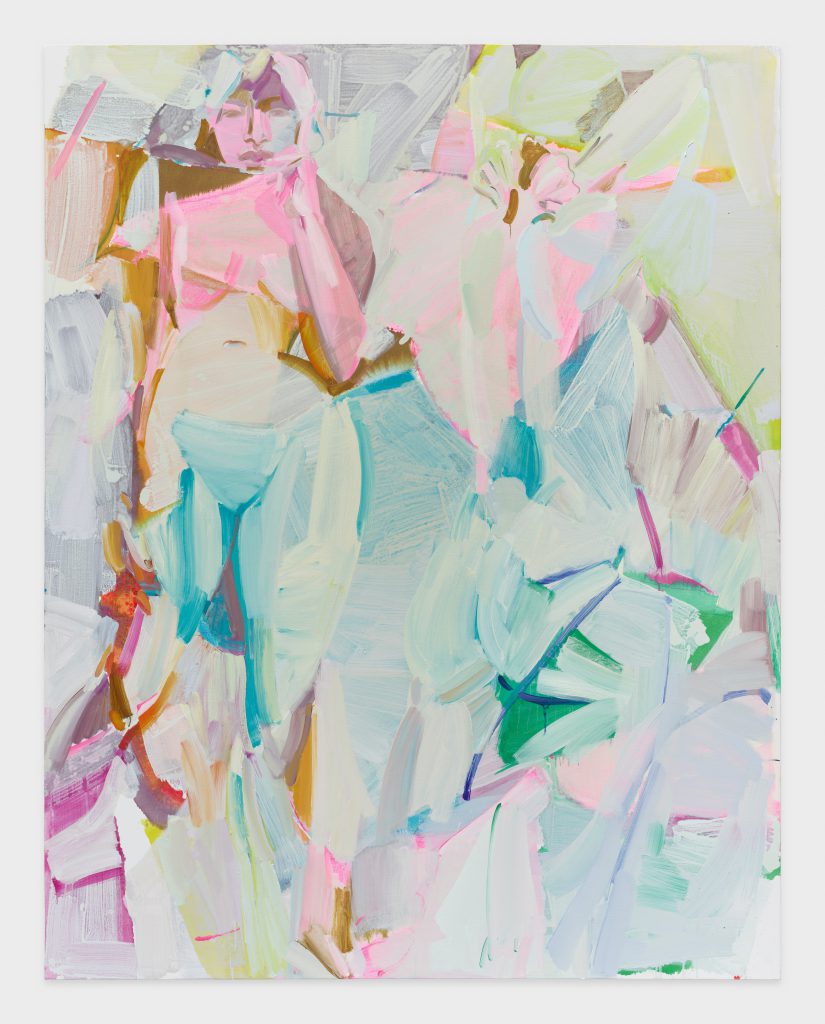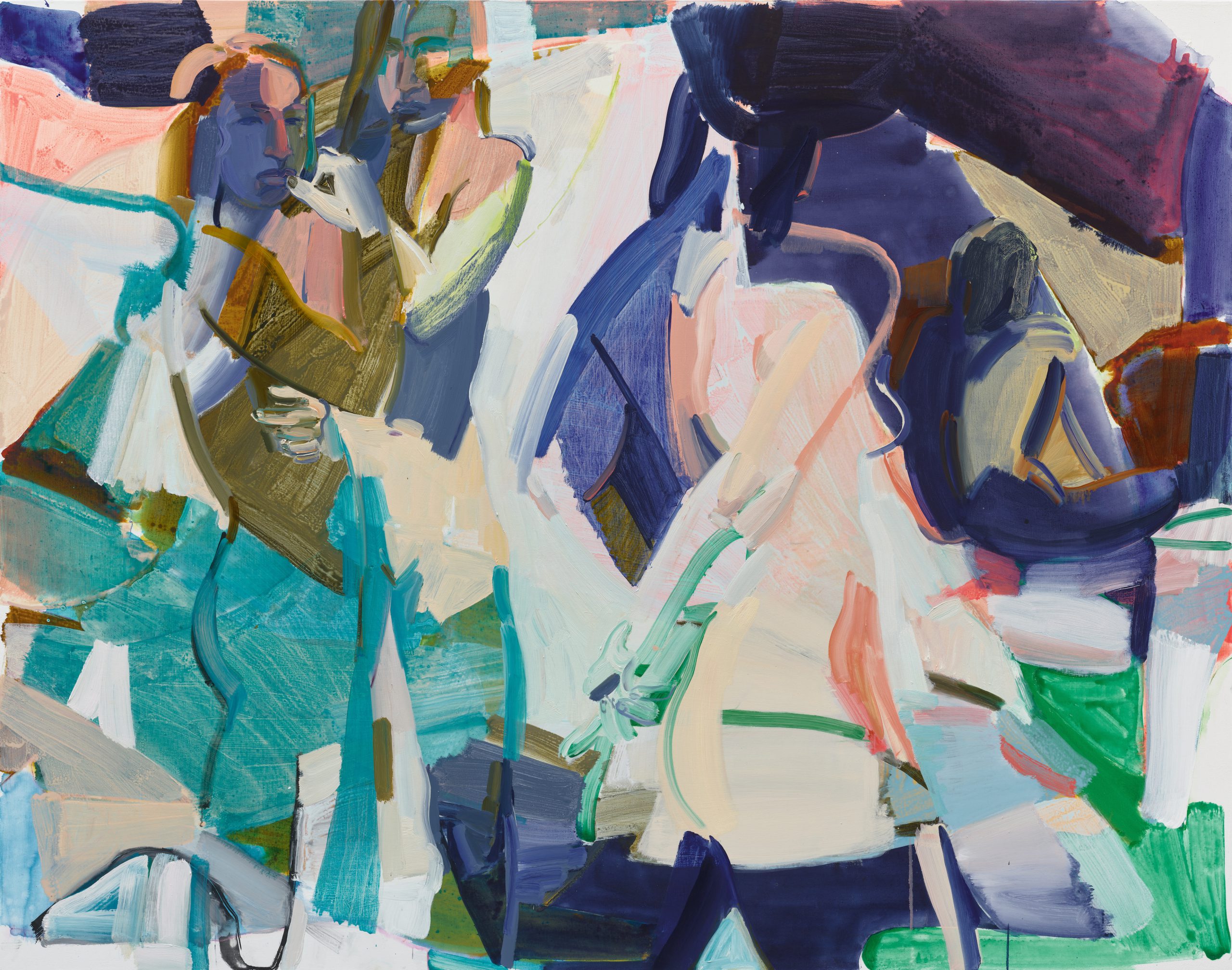Rainbow Clearance and Other Paintings, a recent show by Sarah Awad at The Third Line in Dubai (14 November–16 December 2022) underlined how the artist’s bold and free brushstrokes create a harmony of improvisation and purpose.
In Sarah Awad’s first solo exhibition outside the United States, the two floors of The Third Line gallery space were filled with the Los Angeles-based artist’s dramatic large-scale paintings. A series of new works (all 2022) were on display in Rainbow Clearance and Other Paintings, demonstrating Awad’s approach to abstract painting in a rough and open style that emphasises assorted dark and light colour combinations and simplified configurations of bodies that manifest and dissolve through the use of broad strokes of oil and vinyl on canvas. This was immediately apparent in Night Vision, one of the first pieces encountered upon entering the downstairs gallery, and carried on throughout.
In her compositions, Awad uses a miscellany of free-form paint applications that eventually tease out and reveal the appearance of nude human forms. Wide washy swipes of colour take precedence in the picture until thinner lines and more defined shapes carve out bodies in the frame. Through the fields of colour and irregular shapes emerge legs, torsos, heads, arms and so on. Some paintings, like Limbo, contain multiple characters seemingly in dialogue together, while in other works, such as Rainbow Clearance, a lone silhouette appears looking straight at the viewer through the bright colourful patches of hot pink, cool blue and white.
In some painted arrangements, it is easier to spot the figures. In Neon Pulse, for example, a burst of bright yellow amongst dark and moody navy swatches illuminates a face looking just beyond the viewer and appearing lost in thought. Yet, other images at first glance appear to only be sweeps of colour and vivid geometric abstraction. Then, as one is observing the watery and varicoloured layers of the work and how they overlap and collide with one another, there is a moment of surprise. Subtle suggestions begin to emerge. Letting your eyes rest on the paintings reveals that they are holding faces, bodies, movements and gestures, like optical illusions. The slippery entities come forward and withdraw in the presentations on canvas, making for a captivating experience of seeing.

Nowhere was this more apparent than in Third Eye, the smallest work in the exhibition. The soft lime-green lines and curves against the shades of brown, beige and pink invite you to see something that is hidden in plain sight. The gentle markings pull you into the image, and as you follow the traces they allow you to notice a figure with their hand over their forehead come through in the work. Disappearing Act offers a similar experience, the painting at first appearing completely non-representative, with turquoise blue in the corner colliding with maroon brown in the middle of the canvas, alongside swipes of pink and grey everywhere. Until, out of the dark cluster in the centre appears a body with its bowed head cupped in its hand. Unlocking the finds feels wondrous and satisfying, like cloud gazing or a game of “Where’s Waldo?”. After the first discovery, as a viewer, you were roused to look again, look longer, and look closer at the works.
Awad’s painting process is guided by instinct. However intentional or not the assembly may appear, the compositions are open-ended in their interpretation. The configurations and colour medleys have endless possibilities, prompting the viewer to engage with them further by offering the opportunity to ponder the scene. One of the largest works in the show, Cosmic Harmonizers, presented in the entry gallery, showed two bodies standing in front of each other, as if in conversation, and slightly turned towards the viewer, taking up the left-hand side of the canvas; on the right side were another two bodies, separate and both facing away from the viewer, one seated in the distance and the other walking in that direction.
With the theme of isolation cited in the exhibition text as a running thread in the collection of works, the figurations devoid of narratives took on a particular resonance. The compositions within the canvases explored the proximity and relationship between bodies through the use of either accompanied or solitary figures, and sometimes both at once. Standing as the viewer amongst the works on the walls, there was a sense that you were entering the social interplay with the subjects in the paintings. It seemed as though we were all occupying the same space in the gallery, reciprocally observing and being observed by one another through the surface of the canvas.



